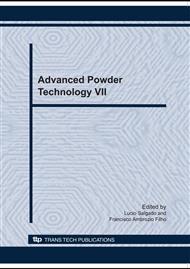p.555
p.561
p.567
p.573
p.581
p.587
p.593
p.599
p.605
Effect of the Salt Solution Concentration in the Number and Size Distribution of Atomized Nanometric Aerosol Particles
Abstract:
The objective of this work is to study the dynamics of nanoparticle formation by atomization of saline solutions at different concentrations. The nanoparticles were generated by a two fluid particle atomizer. Saline solutions were atomized and, with the immediate evaporation of the dispersion liquid in the droplets, resulted in an aerosol of solid nanoparticles. Test replicates were performed with aqueous solutions of sodium chloride (NaCl) at concentrations ranging from 0.01 to 50.0 g/L. The solutions were characterized as for density, viscosity and surface tension. The size and concentration distributions of the particles were measured utilizing a TSI Scanning Mobility Particulate Sizer, SMPS, and the sampling was directly performed in the aerosol cloud. The results showed that, as expected, the increase of the saline solution concentration caused an increase in particle mean diameter. Also, and less obvious, it resulted in an increase in the number of particles. The results, when compared to theoretical prediction, indicate that particle formation and deposition after atomization is responsible for this phenomenon.
Info:
Periodical:
Pages:
581-586
Citation:
Online since:
October 2010
Keywords:
Price:
Сopyright:
© 2010 Trans Tech Publications Ltd. All Rights Reserved
Share:
Citation:


